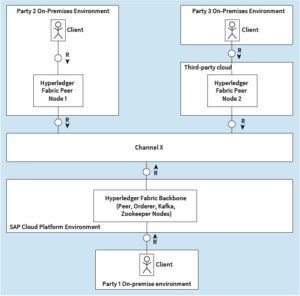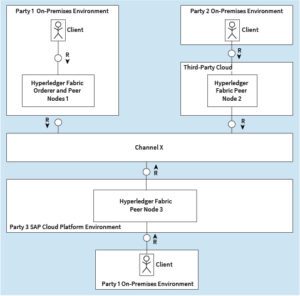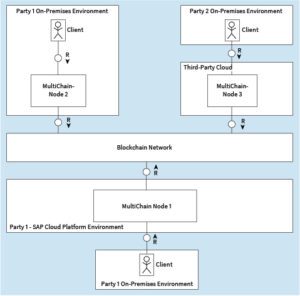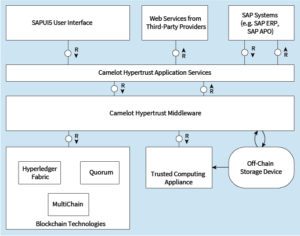This blog post is one article in a series of articles on the book “Blockchain mit SAP” (Rheinwerk Verlag, Bonn, ISBN 978-3-8362-6914-8), which was published in December 2019. This blog post is about the chapter from the book that introduces hybrid network architectures and the Hypertrust platform.
Cross-company blockchain networks are often geographically distributed across international borders and are based on mixed architectures. The distribution of the nodes for the networks can be arranged in various ways. Hybrid architectures are quite common here; these combine nodes on-premises and in the cloud.
For example, the following architecture diagram illustrates a hybrid network architecture for a Hyperledger Fabric network, in which peer nodes are each operated in the SAP Cloud, on a third-party cloud platform, and on premises – a typical setup for a blockchain network.

The central ordering service node is operated in the SAP cloud and is an indication that the network was initiated there.
The opposite case is also possible: with the central ordering service node operated on premises and the peer nodes in the cloud. The following figure shows an example of this type of hybrid network architecture with an on-premises ordering service node, a peer node on the SAP Cloud Platform, and another node in a third-party cloud.

In contrast, other frameworks supported by the SAP Cloud Platform, such as MultiChain and Quorum, offer fully distributed hybrid network architectures because they are lacking “centralized” ordering service nodes type and have only a single type of node.
Below is an architecture diagram of a completely distributed system based on MultiChain, with one node on the SAP Cloud Platform, one node on-premises, and another in a third-party cloud.

Camelot Hypertrust Platform
The Camelot Hypertrust Platform supports all previously introduced network architectures and offers a number of functions to greatly simplify the development and configuration of blockchain networks as well as distributed applications. Hypertrust Platform-based blockchain applications can also be combined with existing systems such as SAP ERP. Below is a diagram of the architecture.

The architecture illustrates the open and modular architecture of the Hypertrust Platform. Node JS based middleware is at the core, functionally abstracting the underlying blockchain technology and acting as a central application server. It supports, for example, the off-chain storage of private or personal data, the connection of Trusted Computing Appliances, and external services.
The Hypertrust Platform also provides a range of convenience features to accelerate the setup and deployment of distributed applications, whether on-premises, mixed or purely in the cloud:


Equipped with this knowledge and the functions of the Hypertrust Platform, you can realize mixed-hybrid network architectures in combination with the SAP Cloud Platform. To this end, the SAP Cloud Platform provides the means to generate cryptographic keys that are required to integrate external blockchain nodes. External nodes use these to connect to the SAP Cloud Platform to establish secure communication channels. For the exact procedure of the connections we refer to the chapter in the book which illustrates the steps for making the different connections in detail and with screenshots – for the secure processing of your data.
More articles of this series can be found here:
- Blockchain with SAP: What is Blockchain and How Does It Work?
- Blockchain with SAP: Blockchain-as-a-Service Products from the SAP Cloud Platform
- Blockchain with SAP: Cloud Computing from SAP: The SAP Cloud Platform
- Blockchain with SAP: Business application scenarios for blockchains
- Blockchain with SAP: The First Steps to Having Your Own Blockchain
- Blockchain with SAP: Developing Applications with Hyperledger Fabric
- Blockchain with SAP: Developing Blockchain Applications with Hyperledger Fabric
- Blockchain with SAP: SAP HANA Integration
- Blockchain with SAP: MultiChain Applications
- Blockchain with SAP: MultiChain Applications
- Blockchain with SAP: Summary and outlook

Would you like to learn more about what the Hypertrust Platform can do for your business? Do you think you have work processes in which Trusted Computing Appliances could play a role? In our book “Blockchain mit SAP” we explain the advantages of this profitable combination in detail. The publisher provides a detailed sample of the book online.
